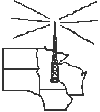 .
.
Back To:
NARC Newsletter
From:
The Northland Antique Radio Club Newsletter
Old Cowboys and Old Radios
By Ed Ripley
It wasn't so long ago that the airwaves were blazing with the sounds of gunfire and horses hooves. Yes, the "Westerns" definitely had their day, and for many of us our childhood included happy hours in front of the radio or TV with a six-shooter cap pistol strapped to our side, and a belt proclaiming our favorite cowboy star. For the more fortunate (and I wasn't one of them) there were little radios designed especially for little cowboys and cowgirls.
The honors for having the very first cowboy radio probably should go to Pilot for the "Lone Ranger" Model G-160 (See page 24, "Radios Redux," Collins). This 1937 wood tabletop model had the famous masked man astride his white horse, Silver, depicted on the dial face, with the name Lone Ranger in red script. A black mask was mounted over the grill.
However the best known cowboy collectible radios came along in the early 50s. Television was largely responsible for giving a boost to the venerable horse opera stars of an earlier time. Hopalong Cassidy actually came out of retirement in the wake of a huge national revival. Capitalizing on the craze, Arvin Industries brought out its Hopalong models in 1950. Offered in bright red or black metal cases, these little sets featured Hoppy on a rearing horse in front of a red cloth grill. The entire front of the radio was covered with pressed aluminum foil which depicted the character and the name "Hopalong Cassidy" in twisted rope script. The metal backplate featured the pressed image of a saddle with protruding pommel for winding the "Lariatenna."
Not to be outdone, the two major catalog houses, Sears Roebuck and Montgomery Ward each marketed their version of a cowboy radio. Wards came with the "Lone Ranger" model in their Christmas 1950 catalog. It was originally produced by Majestic in an enameled bakelite cabinet, very much like the Charlie McCarthy radio of a decade earlier. The Wards Airline version was molded in white styrene, and had a red disc dial. The Lone Ranger with Silver figure was mounted on the left front, and was translucent. When the set is playing a small dial type lamp lights the figure. Rudolph the Red Nosed Reindeer made his radio debut on the exact same cabinet, and was also offered in the Wards Christmas catalog of 1950. Glass snow-globes depicting both the Lone Ranger and Rudy were offered on the same catalog page.
Sears got into the act at about the same time with an unidentified (as far as we know) cowboy on a galloping horse and wielding a rope, which turns into a scripted Silvertone logo. The case is made of black styrene with an ivory figure mounted on the left front grill area. The tuning knob takes the form of either a six-gun or a cowboy hat. (It came both ways.) Teletone built the set for Sears, and except for the dial and character, it's virtually identical in appearance to the standard four tube black Teletone of the period.
Speaking of variations, there are a few Hopalong Cassidy sets where the horse is standing, rather than rearing up. These were produced as the result of considerable criticism by horse lovers who contended that the rearing pose, as shown on the front of the radio, would be very cruel to a horse. Not wishing to offend, actor Bill Boyd, who played Hopalong Cassidy on the screen, insisted that Arvin change the radio figure, which they did, but apparently quite late in the model run, because the standing horse version is not often seen.
Internally, all three of the cowboy sets used a 4 tube chassis and long wire antenna. The Arvin Hoppy sets differed in that they used the larger octal base tubes, while the Sears and Wards models each offered four miniatures. The Hoppy and Lone Ranger sets sold for around $16.00 to $17.00 at the time of their introduction. The Sears set probably sold in the same price range.
All of these cowboy sets fall into the "tube-type character radio" category. Their value has been fairly steady for several years, probably peaking in the early '90s at about the same time the Catalin craze was at its height. More recently, they slipped back a bit in value and currently seem to be climbing again. Today, a good specimen of any of them can set a collector back anywhere from $350 to $800. It's hard to say which of the cowboy radios is the most collectible. Hoppy is probably best known and most frequently seen, and the Airline or Majestic Lone Ranger seems to be the most sought after. The Silvertone cowboy is hard to find, especially in good condition, and the Pilot version of the Lone Ranger is extremely scarce. In fact, in more than 15 years of radio collecting, this writer has never actually seen one, let alone had the chance to buy it. So, if you find a cowboy radio, any one of them, grab on, pardner! You've found a goody.
Copyright 2024. All rights reserved.
The Northland Antique Radio Club